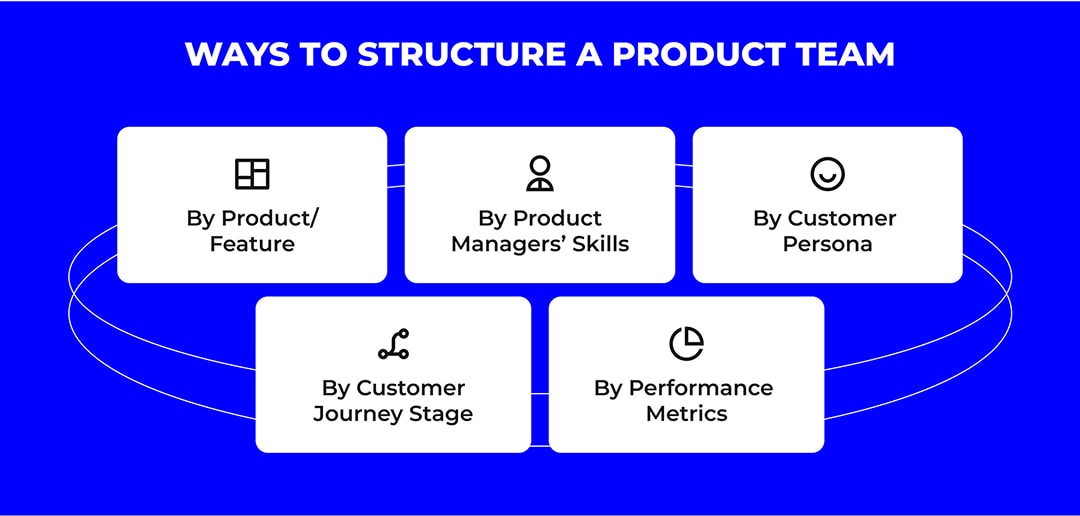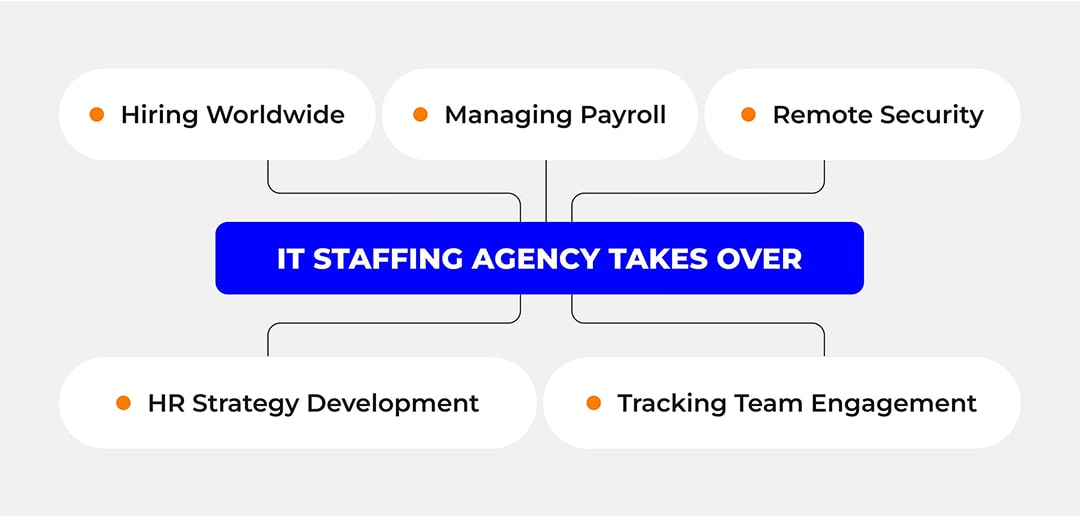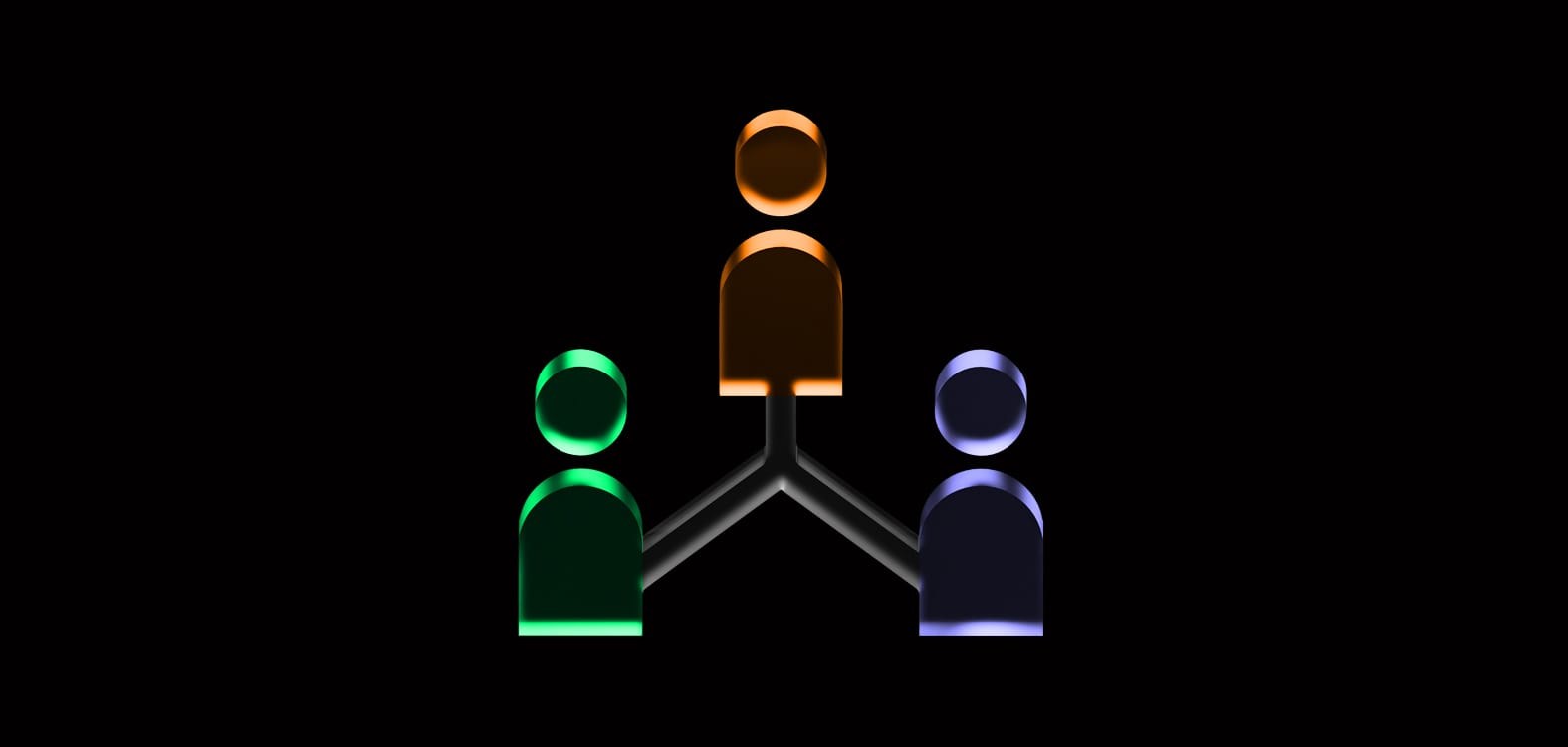If we expect a commercial success from our venture, how to structure a product team? Just hiring a specialist each time you see a skill gap is not enough. When a team is growing without a strategy, a company revenue reduces because of overlapping functions, communication gaps and other anomalies typical for screwed-up project management.
As a tech recruiting services provider, we partner with companies of various sizes and see how they structure product teams to meet their business objectives, grow, and optimize IT staffing prices at the same time.
Can you guess what is our first strategic tip? Band over backwards and try to be exactly as tech giants, or experiment with types of product team structures?
The answer is almost in your pocket ⬇️
How to Structure Product Teams?
The insight #1. There's no need to copy giants like Amazon or Netflix exactly. While they're leaders in product development, their structures might not be the perfect fit for your team. Here's why considering a custom approach might be better.
You, most likely, have another company size and complexity. Amazon, a massive organization with diverse product lines, can support specialized roles. While a startup product team structure is not so complicated. A smaller business might need all-rounders who can handle multiple aspects.
Your product might be not so feature-rich yet. A complex product like Netflix's recommendation engine might require a dedicated feature owner, while a simpler app might be managed by a single product manager.
Get skill gaps analysis and matching candidates for your product team roles.
Contact your talent provider
The insight #2. With any product team structure example you follow, ensure the team stays obsessed with understanding and meeting customer needs.
Modelling Your Product Team Structure
How to structure product teams, then? No matter how much business literature you read, or no matter how many business schools you attend, your business has its own unique mission, and therefore its own product team structure at various growth stages.

To start a project and gain a momentum faster, I’d gather pros developing one feature on one team and make an emphasis on the available product managers’ skills. To improve the existing product and customer experience, I’d unite team members optimizing the product for acquisition, activation, or retention, as well as opt for assigning certain teams responsible for certain metrics needed to track a business outcome.
We have noticed that none of our clients sticks to a "classic" team structure or methodology. In this regard, they act like a lot of tech giants, just like Google or Amazon: be yourself and let your existing strengths and development style determine your product team organizational structure.
Google has separate teams for search, ads, cloud, etc., each focusing on specific functional areas. Yet, many teams at Spotify use the Agile methodology, with squads working autonomously on different features of the Spotify app.
Amazon adopts a mix of functional and product team structures, often organized as "two-pizza teams" (teams small enough to be fed by two pizzas) to maintain agility and innovation. Yet, Netflix employs DevOps practices to ensure smooth delivery and operations of their streaming service, enabling rapid development cycles.
Teams at Google can change and evolve quickly based on project needs. Yet, Apple keeps specialized teams working together to deepen the functional expertise.
How to Structure a Product Team For Easy Scaling?
Pick Your Scaling Type
I recommend you first understand what your product or service needs for scaling. Is scale dependent on people with certain expertise? Or is its scale dependent on marketing? Or is it dependent on infrastructure scale? Based on that, invest into what scales your company.
If talk about software or tech companies, we typically see a hybrid approach to growth, based on the 4 pillars.
Scale with automation — delegate routine tasks to AI and algorithms. I'd suggest looking into what can be automated first, then what processes need more people and with what expertise.
Scale with development team growth and innovation — to roll out faster, you sometimes need more hands on deck, that’s simple. If a product team is small you can suffice with one Tech Lead who wears multiple hats (CTO, Tech Lead, Architecture Director, etc.). If a team is big, you can divide it based on projects, or by verticals (e.g. Integrations, Front-end, Back-end, System Administration, etc.), or you can have cross-functional parallel teams (1 back-end, 1 front-end, 1 QA, etc. for each team).
Scale with attracting new and retaining “old” customers. Hire seasoned marketers, salespeople, and customer support team.
Scale with providers — some non-core business processes can be delegated to experts in the field. Delegating People Ops is one of the widespread IT engagement models. Professional staffing agencies possess HR-specific knowledge, allowing you to get the most out of your hires. And if you opt for special services (check PEO vs. EoR to see the difference) designed to legally and risk-free engage overseas tech talent, you can get better cost per hire. For instance, our service fee for recruitment and EoR services is flexible and lower than maintaining and constantly upskilling an in-house HR team specialized in tech hiring.

Questions to ask yourself to take a scaling decision:
How fast information flows in each of the structures in your company?
How fast results are delivered?
Is everyone in the team on the same level, or if someone needs systemic mentorship?
Consider No-Code and Low-Code Platforms
Is faster turnaround what you expect from your team when your business grows? With low-code and no-code tools, non-technical team members can build applications without relying solely on IT. These tools enable real-time collaboration, allowing multiple team members to work on the same application simultaneously — voilà, your IT specialists are not overloaded while your team is more engaged and creative as they have more freedom to test their hypotheses. Moreover, this increased flexibility helps teams respond quicker to changing market conditions and customer needs.
Improve Communication Frameworks
I’d choose the main channels of communication first. Discord? Fine, let everyone exchange info there. Jira? Sounds good. The main thing is for everyone to stick to a few communication channels that have an agreed purpose.
Give a certain standard of communication. How are tasks set in your organization. Who is responsible, who is a collaborator, who is setting estimates, etc.? Once you have one principle worked out, communicate it to everyone, and make sure the habit sticks.
Encourage cross-team feedback sharing. Every team and department complements the other one. And it's essential that you show all of them how each of these departments contributes to the company's mission.
Your team retention could
be on us — structured milestone
talks and predictable
team players.

It's good to hold cross-departmental team buildings to help them strengthen the bond, and show how they can effectively collaborate. You can do anything that works for your business, e.g. intellectual games, cross-team projects.
Build Project Management Teams
Within agile projects, product managers often serve as product owners who coordinate scrum teams. Each scrum team might consist of Product Owner, Developers, Designers, QA Engineers, and, sometimes, a Scrum Master.
The Product Owner ensures that the development aligns with the product goals and customer needs. Product Owners can report to the CEO, CTO, or their own managers. Hence, a product management team is needed when a company grows, a project branches out, and top managers cannot longer directly manage all the product owners. In large-scale companies, the product management team structure often unites PMs by areas of responsibility and can include several “floors”.
PM Team Example
Chief Product Officer (CPO)
-
Director of Product Management — Product Line A
Product Manager — Feature A1
Product Manager — Feature A2
-
Director of Product Management — Product Line B
Product Manager — Feature B1
Associate Product Manager
-
Director of Technical Product Management
Technical Product Manager — Platform
-
Head of Product Operations
Product Operations Specialist
How Recruiters Can Help You Create Good Product Team Structure?
With a dedicated product team and well-built product team structure, it can be easier to make informed decisions, innovate, and achieve long-term goals than, for instance, with consulting development services.
Dedicated developers better understand the product. They feel a greater sense of ownership and accountability towards the product's success. The longer you retain specialists on your team, the more competitive and close-knitted they become. Here the IT recruiters step in, and you can task them with your concern in how to structure a product team with little to no turnover.

While CEOs and product leaders work on product development, good recruiters study the company's vision, product roadmap, and desired team dynamics. Then, they tailor their search based on the chosen product team organizational structure.
By analyzing current team strengths and weaknesses, recruiters can pinpoint the specific skills and roles needed to achieve product goals.
By seeking candidates with diverse backgrounds, experiences, and thinking styles, recruiters help avoid mis-hires. Versatile team members can build initial roles and then move into specialist positions in their domains.
Beyond technical skills, recruiters should assess how well candidates would integrate with the existing team culture and values.
We stick to all the principles above. For instance, our Talent Acquisition team focuses on generalists for a small team or specialists for a complex product in a larger company. If you are building an MVP, we’d hire people who can work quickly and collaboratively. And for a scalable product, we’d seek those with experience in enterprise solutions or large-scale apps.
In case we become a company’s People Partner, we play ahead:
Collaborate with product leaders to identify high-potential candidates who can take on leadership roles in the future;
Maintain a strong talent pool to fill all the new team roles at a blink of an eye to keep a client’s agile software development team running smoothly.
And provide strategic HR Consultancy, because if you partner with niche specialists like IT staffing agencies, you get partners who perfectly navigate the industry trends and competitor landscapes to identify top product managers and more.
It may be unexpected to hear, but a bunch of specialists within the IT sector don’t consider Google, Amazon and other stars as the ideal places to work at. When a lot of experienced pros meet in one team, some of them may need to perform entry-level tasks. This makes seasoned developers look for projects where they will be treated like strategists. When corporate policies make professional communication too formal and limited, it also became a red flag for many specialists who value openness and friendly vibes. The list of why’s is longer than you might imagine.
You can win a battle for talent and successfully negotiate compensations if you know how your candidates think. We at Outstaff Your Team know! Developing an ideal product team structure is what we can do for you, based on our past hiring successes and studying your unique team fit. Share your plans and requests — get an expert and responsive HR support.
FAQ
Should I hire a dedicated product manager for each feature?
It depends on the scope of work needed to develop, test, deploy, and maintain this feature. Only large-scale features need dedicated PMs. In other cases, one PM can handle multiple features.
How can I scale my product team structure as the company grows?
Before growing a product team, delegate routine tasks to AI and algorithms. Thus, you can significantly reduce the number of essential hires. Base new product team roles on skill-sets that precisely cover the skill gaps on your team. Assign product leaders responsible for different development goals, like improving a product’s user interface, speeding up its loading time, or supporting more and more customers. Build specialized teams within your product team, but keep all the teams synced.
How can I sync my product team with other departments?
You can improve communication between product, engineering, marketing, and sales teams by:
Choosing main channels of communication;
Giving a certain standard of communication;
Encouraging cross-team feedback sharing;
Holding regular cross-team meetings, both operational and informal.
Ann Kuss is the CEO at Outstaff Your Team. After 11 years of expertise in building remote tech teams for startup unicorns and global tech brands, Ann decided to lead a new venture aiming to reinvent the way international tech teams scale. Throughout her career, Ann hired specialists for countless tech positions from more than 17 countries on all major continents. Ann graduated from Kyiv-Mohyla business school, is an MIM Kyiv alumna, and regularly takes part in mentorship programs for junior tech talents. Ann actively promotes knowledge sharing and curates Outstaff Your Team blog strategy, preferring topics that solve practical needs of IT leaders. She believes that structuring business flows (including hiring) is a well-planned journey with predictable and successful outcome.



